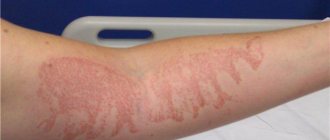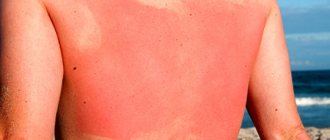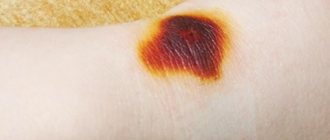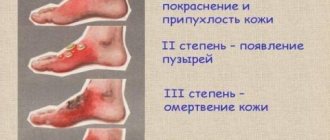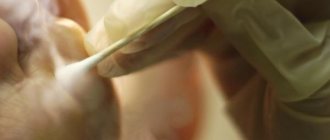Electrical burns are quite common in combustiological practice. Such damage occurs when the human body is exposed to electric current. Injuries caused by electricity are very dangerous because they have a direct effect on cardiac activity and often lead to the death of the victim.
Electrical burns include not only electric shock from outlets, wires and electrical appliances, but also from lightning strikes. When an electrical burn occurs, two wounds are created on the human body—the points where electricity enters and exits. These two injuries can be in paired organs, for example, in one and the other leg, or in opposite parts of the human body.
Features of electrical burns
The main danger of electric shock is that electrical burns are a highly unpredictable injury. Unlike a thermal burn, for example, when you touch a hot iron and immediately feel pain, when receiving an electric shock there is no pain.
The burned area loses sensitivity, and a so-called electrical mark (sign) appears at the point of contact with the current source - an area of reddened or charred skin (depending on the degree of the burn). It is usually gray or brown in color and has a slight indentation in the center; marks are oval, rounded and in the form of stripes (when struck by lightning).
Thermal effect
According to the Joule-Lenz law, the thermal effect of current depends on tissue resistance, current strength and time of contact with it. The amount of heat generated by the passage of current is proportional to the product of the square of the current (in amperes) by the resistance (in ohms) and time (in seconds). Current strength, according to Ohm's law, is inversely proportional to tissue resistance. The contact area also matters: the smaller the area, the greater the current density, and the more electrical energy is converted into thermal energy in a certain area of the body.
The thermal effect of the current causes a burn with tissue necrosis to charring. Skin and bones are more damaged because their density and resistance are greater than those of other tissues. Sometimes X-rays show characteristic changes in the bones in the form of a pearl necklace, which occurs due to the melting of bone tissue and the release of calcium phosphate.
The mechanical (dynamic) action of high-power current can lead to tissue delamination, ruptures, even to the separation of body parts. This is due to the fact that high voltage current, in addition to thermal effects, has significant mechanical energy, which gives an explosive effect. The increased air pressure during an explosion can throw a person to the side.
Electrical burn
What is the danger of electric shock? The fact is that electric current entering our body passes through a path called a loop. With his careless touch, a person caught under voltage closes the circuit and receives not only skin burns at the point of entry and exit of the current, but also internal damage to tissues, blood vessels, and organs.
The most dangerous is a full loop, when the electric current passes through both upper and lower limbs. The least dangerous is the lower one, when an electric current passes through the feet in contact with the ground or metal.
When receiving an electric shock, the victim receives various types of damage:
Sometimes electrometallization of the skin occurs, when the smallest particles of molten metal penetrate the skin at the site of electric shock, and electroophthalmia is inflammation of the eyes under the influence of ultraviolet radiation (this is possible due to a short circuit of the electric arc).
The child has
According to statistics, electrical injury is diagnosed in every 10th child admitted to the burn department, and in 25% of cases the injury leads to death. At risk are children from one to 5 years of age (injured when they come into contact with a faulty electrical device connected to the network, when playing with sockets) and teenagers (they receive an electric shock when entering electrical substations, train cars, power line supports). And very rarely the cause of injury is a lightning strike.
Providing first aid to a child and treating an electrical injury is carried out in the same way as for adults. But a child’s body needs much more time to fully recover. And even after a long period of time, children can develop serious complications:
- damage to the nervous system - asthenia (a disorder accompanied by a decrease in physical and mental performance), encephalopathy (brain damage), neuritis (inflammation of peripheral nerves), paresis (partial paralysis);
- pathologies of the cardiovascular system - cardiac muscle conduction disturbances, microcardiodystrophy;
- autonomic disorders - hair loss, hyperhidrosis (increased sweating throughout the body or in certain areas);
- hearing impairment, hearing loss;
- cataract (clouding of the lens of the eye, leading to blurred vision or complete blindness).
Electrical burns are the most dangerous injuries, often leading to disability or death. It is extremely important to observe safety precautions when working with industrial electrical installations and household appliances. To prevent injury to a child, it is necessary to block access to sockets, monitor the serviceability of electrical equipment and the integrity of the insulation of electrical wires, and conduct explanatory conversations about the inadmissibility of playing with electrical appliances and near energy facilities.
How to understand that a person has suffered from an electric shock?
Symptoms of an electrical burn include:
- Shallow breathing
- Cardiopalmus
- Loss of consciousness
- Convulsions
The victim may complain of weakness, dizziness, and nausea. Be sure to examine him for the presence of electrical marks (if a person has been under voltage for some time, then there may be many of them - multiple electrical burns).
Deep damage is indicated by the appearance of swelling at the site of contact with the current source, tension in the mouse and a complete lack of sensitivity.
Degrees of pathology
There are 4 degrees of electrical burns:
- First degree. It is the easiest and safest for health. But people with heart problems need to be treated immediately and taken to the nearest hospital for examination. With correct first aid, further treatment can be continued at home.
- Second degree. An electrical burn damages deeper layers of tissue. In this case, blisters appear at the affected areas. If more than 1% of the body is injured, then you need to seek help from a surgeon and therapist. During the examination, an ECG is prescribed, blood pressure is measured, and urine and blood tests are taken. Further treatment can be carried out at home, but under the strict supervision of a doctor.
- Third degree. Necrosis of the affected tissue is characteristic. In the case when the skin becomes dark and the patient does not feel pain at all, this indicates tissue necrosis without any possibility of their restoration. With such an injury, the patient loses consciousness, problems with breathing and heart, arrhythmia, and active muscle contraction are observed. Hospitalization is required.
- Fourth degree. Charring occurs not only of the skin, but also of fatty tissue, as well as muscle and bone tissue, and all internal organs are affected. In most cases it ends in death.
First aid for electrical burns
First of all, it is important to stop the traumatic impact on the victim. If it is “stuck” to the current source, you must open the circuit. Unplug the cord from the outlet or simply drag the person away.
Be very careful! Don't put yourself under stress. You can push a person away with a wooden or plastic stick, a stool, or your foot if you are wearing shoes without metal parts and with rubber soles. Under no circumstances should you step into water if it is in the immediate vicinity of a power source!
- If the victim is conscious, ask him about his health, and then call emergency help.
- Check the pulse and breathing of an unconscious person. If they are absent, immediately begin resuscitation actions: perform chest compressions and artificial respiration.
- Try to raise your torso above your head - place rolled up clothes or a blanket under the victim’s feet.
- Examine the victim for injuries - if he was thrown by the electric current, the person could have suffered fractures or other injuries.
- Try to locate areas of electrical burns (current inlets and outlets). Cover the burns with a bandage or gauze to ensure sterility.
Kinds
Types of electrical burns:
- Current (or otherwise contact);
- Arc.
They are distinguished by their effect on the skin and by the general well-being of a person.
An electric burn occurs during direct interaction between a person and a current carrier. At the same time, a current pierces the body.
An arc burn is fraught with consequences. Appears during contact with an electric arc on the victim.
Treatment of electrical burns
Low-voltage electrical burns received at home most often affect a small area and are located on the hands and feet, sometimes in the corners of the mouth, and on the lips. They usually heal within 7-10 days.
To speed up the regeneration process of injured skin, use special healing products. The La-Cri cream for sensitive skin, which contains natural non-hormonal components, has proven itself to be excellent. Its complex composition allows you to simultaneously influence all manifestations of inflammation. The product copes well with skin irritations, promotes rapid healing of burns, and is suitable for adults and children.
Treat the inflamed area with La-Cri cream 1-2 times a day until complete healing, and soon you will forget about irritation. The main thing is to remember the safety rules when using electrical appliances.
Further recovery
If the injury is superficial, the victim is not hospitalized. 1st and 2nd degree burns are treated at home with local anti-burn agents. But before sending the patient home, the doctor must examine him for hidden systemic effects. In critical cases - 3rd and 4th degree burns - treatment is carried out in a hospital.
If the patient’s general well-being worsens, they speak of an electrical injury. Its manifestations include:
- muscle cramps;
- rapid heartbeat;
- shallow breathing;
- loss of consciousness, etc.
For relatively shallow skin lesions, treatment with local drugs is limited. Burns are treated with the following means:
- anti-burn (Bepanten, Dexpanthenol, Olazol) - eliminate inflammation, stimulate cellular metabolism and scarring of the burned epidermis;
- regenerating (Solcoseryl, Actovegin) - improves the supply of oxygen and glucose to the skin, thereby accelerating its regeneration;
- antiseptic (Chlorhexidine, Nitrofural) - destroy pathogens, prevent infectious inflammation of wounds;
- painkillers (Nimid, Amidopyrine) - reduce the sensitivity of pain receptors and discomfort in burned areas of the body.
Electric current with a voltage of more than 40 V causes deep burns, dysfunction of the nervous and endocrine systems, and myocardial contractile activity. Treatment of such patients involves various therapeutic procedures:
- infusion therapy with Ringer-Locke solution, 5% glucose;
- applying dressings with Levosin or Levomekol;
- taking sedatives, antidepressants, cardiac glycosides.
We suggest you read: How to stop hair loss in women and increase their thickness
Clinical trials
The conducted clinical study proves the high efficiency, safety and tolerability of products for daily skin care of children and adults with mild and moderate forms of atopic dermatitis and during remission, accompanied by a decrease in the quality of life of patients. As a result of therapy, a decrease in the activity of the inflammatory process, a decrease in dryness, itching and flaking was noted.
Clinical research has confirmed the following properties of La-Cri cream for sensitive skin:
- Removing redness;
- Skin moisturizing;
- Gentle skin care.
Based on the results of joint research, the following information is placed on product packaging: “Recommended by the St. Petersburg branch of the Union of Pediatricians of Russia.”
Consumer review
kira_malinina_89 (irecommend.ru)
“I’ll tell you a little story about using La-Cri cream for sensitive skin. I bought it because I actually have sensitive skin and constantly break out on something. During cold weather and wind, the whole face and hands are red and itchy periodically 24/7. Hormonal ointments certainly help, but after them everything returns almost immediately, plus the hormonal balance is slightly confused. So I use them as a last resort. And this cream is non-hormonal, with a fairly natural composition. (There is extract of violet, avocado, walnut, etc. The smell is very pleasant!) As for the consistency, the cream is quite thick and because of this it moisturizes the skin well. The itching goes away almost immediately, and my skin tone has improved after just a few uses. There is no addiction, I used it for two weeks, then I stopped and the effect did not disappear and did not get worse. So you can take it with confidence. Another funny moment. My son burned himself with nettles and I decided to apply this cream to the burn. So the itching and redness went away in about 10 minutes and the child was happy)) so this cream is generally suitable for different skin situations, I really like it.”
Sources:
- Kovyazina N.A., Fedosimova N.A., Illek Ya. Yu. Diagnosis of atopic dermatitis in young children, Vyatka Medical Bulletin, 2007 https://cyberleninka.ru/article/v/diagnostika-atopicheskogo-dermatita-u- children-early-vozrasta
- Smirnova G.I. Managing the course of the disease: atopic dermatitis in children, Russian pediatric journal, 2014 https://cyberleninka.ru/article/v/upravlenie-techeniem-bolezni-atopicheskiy-dermatit-u-detey
- Mancini A. J., Krouchuk D. P., Pediatric dermatology. Publisher: Practical Medicine, Directory, 2018
- Kildiyarova Rita Rafgatovna, Pediatrician for every day. Guide for doctors, publishing house GEOTAR-Media, 2020.
